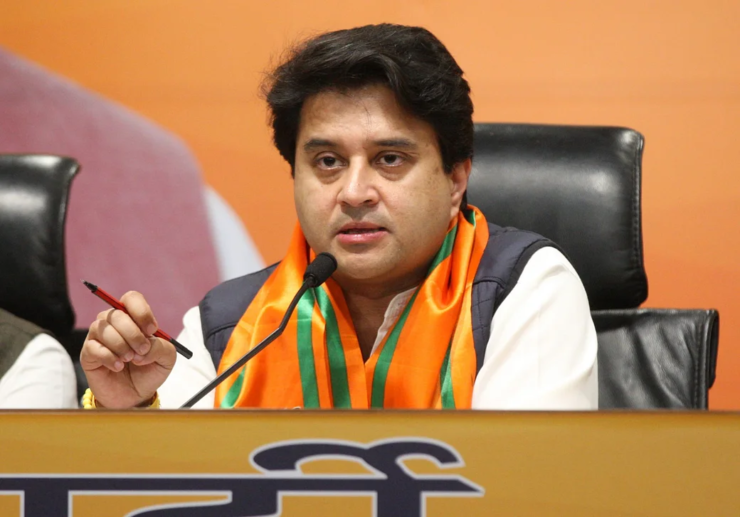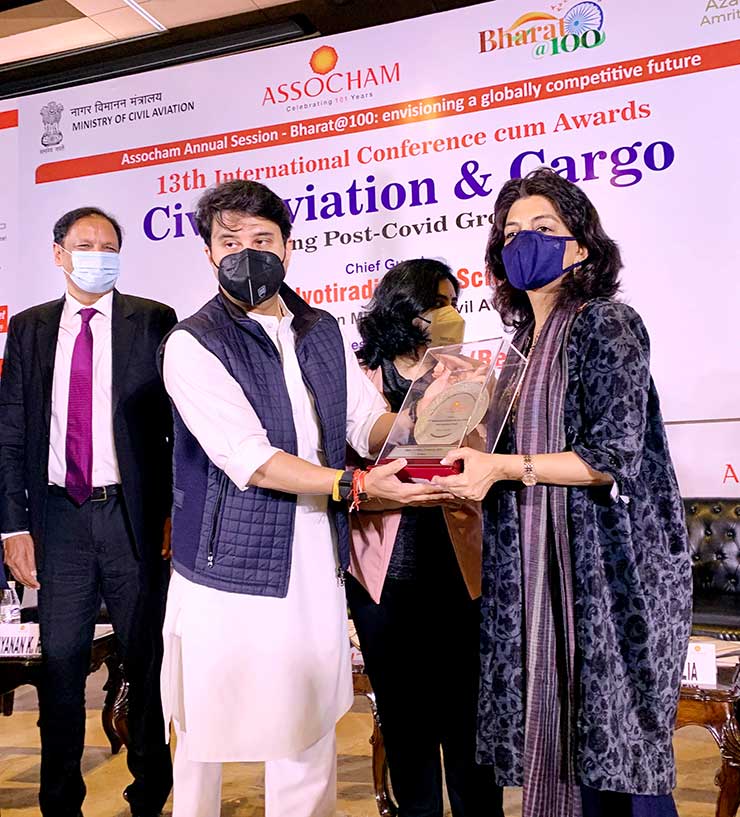
New Delhi: With the government giving a boost to the civil aviation and infrastructure development like airports, Indian civil aviation sector has tremendous potential to become backbone of transportation in the country said Civil Aviation Minister Jyotiraditya Scindia giving away the ASSOCHAM Awards on Civil Aviation and Cargo.
Leading aviation company Pratt and Whitney received the award as the “Best Aviation Sustainable Technology Provider 2021,” from the Minister who said, this sector not only presents huge potential for domestic requirements, but for the global aviation industry.
Addressing the 13th International Conference cum Awards on Civil Aviation Cargo with theme ‘Driving Post-COVID Growth’ in the capital, the Minister said, several positive measures have been taken by the government to address the challenges faced by the Indian aviation industry, including GST on Aviation Turbine Fuel ATF, new Airports and capacity at existing airports, streamlining of freight management and others.
Talking about the tremendous growth industry has achieved in terms of numbers of airports from 74 to 140 in last eight years, he expressed confidence that aviation industry in the country may be having 1000 to 2000 fleet of aircraft in next 10 to 15 years which could well boost the aviation sector considering that it had gone through a lean patch at the time of the pandemic which had affected the nation’s economy which now was picking up.
The government is working on a policy for regional airlines and helicopter operators so as to boost last mile connectivity, Scindia said. He emphasized that there was need for smaller town airports as well as regional connectivity in India.
“That poses its own sets of issues — economies of scale, leasing costs and pricing — and those are the things we are exploring today,” he said at an event organised by industry body ASSOCHAM. “We are going to come out with a policy for regional airlines and for helicopters to make them much more economical, to make them much more pervasive, and to provide that last mile connectivity because growth is also going to come from that sector,” he said.

The growth opportunity is coming from smaller cities like Jharsuguda in Odisha and Rupsi in Assam, he said. “We have to provide the last mile connectivity,” the minister said.
Stating that penetration of helicopters today in India is negligible having only about 130-140 civil helicopters, he said while developed countries have helicopters in thousands, “we have to come out with a policy that makes it possible for helicopters to drive the growth especially in north eastern states and in the island states…that is something that I am working on as we speak.”
Aviation sector in India is at an early part of its growth stage and it’s going to become the backbone of the transportation of our country, remarked the civil aviation minister. “Auto sector is known today by the OEMs (original equipment manufacturers) and I want the airline ecosystem to grow similarly. In the success of this aviation sector is the success of the government,” he noted.
Receiving the award on behalf of Pratt & Whitney, at 13th Annual International Conference-cum-Awards on Civil Aviation and Cargo, Ms Ashmita Sethi who is President and Country Head of the company said “Pratt & Whitney is committed to supporting our Indian airline customers in making flying more sustainable and efficient through innovations like our GTF engine, our Hybrid Electric demonstrator and our focus on SAFs as a ‘drop-in’ solution.”
We have a big opportunity in form of MRO. MRO will contribute greatly to our #GDP & which we haven’t been able to monetize for India, she tweeted.
As Pratt & Whitney’s senior-most in-country leader, Sethi provides strategic direction for the Company’s growth and business goals in India, and drive all of Pratt & Whitney’s operations in India, including customer relations and support, the company’s Customer Training Centre in Hyderabad, Communications and Governmental Affairs. She brings more than 20 years of experience from the defence and aerospace industry to this role at Pratt & Whitney.
The company has a long and proud history in India. From the Wasp-powered Douglas DC-3 in the 1940s to the JT3D-powered Boeing 707 in the 1960s, Pratt and Whitney has long been the engines behind the nation’s airlines, defence, medical services and have more than 700 employees throughout India and a growing number of locations. These include business and technical offices, a world-class customer training centre, engine maintenance facilities and a large team of field service representatives. The Pratt & Whitney India Training Center in Hyderabad provides state-of-the-art engine maintenance and performance training.
Eleven states had VAT rate on aviation turbine fuel (ATF) between one and four per cent and 25 states had between 15 and 30 per cent when I took charge as the Aviation Minister. The Centre then went to states and helped them understand that lowering the VAT rate on ATF will assist them in boosting economic growth and tourism, Scindia said.
In the last over six months, 12 more states have brought their VAT rate on ATF in 1-4 per cent bracket. “Let me assure you that I would not rest until VAT is reduced in all states. I have 13 more states to deal with,” he added. The minister was talking about the 13 states that have the VAT rate on ATF between 15 and 30 per cent.
Meanwhile, it needs to be emphasized that Airports Authority of India (AAI) will connect 22 airports under Regional Connectivity Scheme (RCS) in the first phase. These 22 airports include one in Andaman Nicobar, three in Assam, two each in Gujarat, Uttar Pradesh, Punjab and Rajasthan. Under RCS, plans are to connect these underserved airports to key airports through flights that will cost Rs 2,500 for per hour flight. RCS envisages to provide subsidy to airlines to offer these fares. AAI would invest Rs 17,500 crore in upgrading airport infrastructure over a period till 2019-20. Among the key aims of this regional connectivity scheme is to be make flying affordable for the masses.
On the occasion, Scindia also gave away excellence awards in various categories to the airports, freight management agencies, ground handling agencies, training institutes and others. The aim of the conference was to outline the prominent pain points that the industry is facing – pre or post pandemic – and find specific solutions to relieve stress from Civil Aviation Sector, make it self-sustainable and economically viable.








